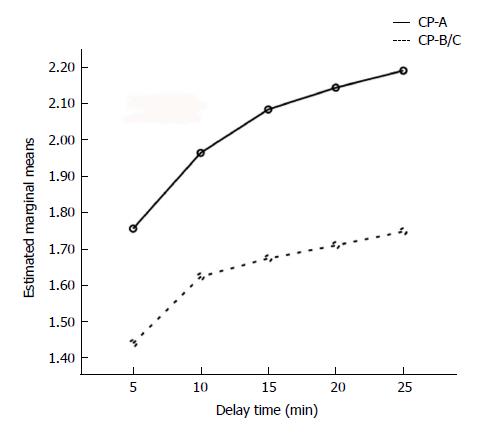Copyright
©The Author(s) 2018.
World J Gastroenterol. Jan 21, 2018; 24(3): 415-423
Published online Jan 21, 2018. doi: 10.3748/wjg.v24.i3.415
Published online Jan 21, 2018. doi: 10.3748/wjg.v24.i3.415
Figure 1 Liver parenchyma signal intensity varying with the hepatobiliary phase delay time of Gd-EOB-DTPA-enhanced magnetic resonance imaging in cirrhotic groups and healthy controls.
Figure 2 Liver parenchyma/ hepatocellular carcinoma signal ratios varying with the hepatobiliary phase delay time of Gd-EOB-DTPA-enhanced magnetic resonance imaging between Child-Pugh (CP)-A and CP-B/C subgroups.
Figure 3 Visibility of a hepatocellular carcinoma focus at different hepatobiliary phase delay time points in a patient with Child-Pugh A cirrhosis.
An HCC focus of 0.8 cm × 0.8 cm was found in the right rear lobe of the liver in a 53-year-old female patient with cirrhosis caused by chronic hepatitis B. Gd-EOB-DTPA-enhanced magnetic resonance imaging shows a strong contrast between liver parenchyma and HCC focus presenting as obvious hypointensity (+++). The contrast at DT-10 is enough to identify the HCC focus. HCC: Hepatocellular carcinoma.
Figure 4 Visibility of a hepatocellular carcinoma focus at different hepatobiliary phase delay time points in a patient with Child-Pugh B cirrhosis.
An HCC focus of 3.6 cm × 3.3 cm was found in the right lobe of the liver in a 58-year-old male patient who was diagnosed with chronic hepatitis B-related cirrhosis. Gd-EOB-DTPA-enhanced magnetic resonance imaging shows a moderate contrast between liver parenchyma and HCC focus presenting as moderate hypointensity (++). The contrast at DT-10 is enough to identify the HCC focus. HCC: Hepatocellular carcinoma.
Figure 5 Visibility of a hepatocellular carcinoma focus at different hepatobiliary phase delay time points in a patient with Child-Pugh C cirrhosis.
An HCC focus of 1.5 cm × 1.7 cm was found in the right lobe of the liver in a 38-year-old male patient who was diagnosed with chronic hepatitis B-related cirrhosis. Gd-EOB-DTPA-enhanced magnetic resonance imaging shows a weak contrast between liver parenchyma and HCC focus presenting as mild hypointensity (+/–). It seems that a longer DT (such as DT-15, DT-20, or DT-25) could slightly improve the visualization of HCC focus. HCC: Hepatocellular carcinoma.
- Citation: Wu JW, Yu YC, Qu XL, Zhang Y, Gao H. Optimization of hepatobiliary phase delay time of Gd-EOB-DTPA-enhanced magnetic resonance imaging for identification of hepatocellular carcinoma in patients with cirrhosis of different degrees of severity. World J Gastroenterol 2018; 24(3): 415-423
- URL: https://www.wjgnet.com/1007-9327/full/v24/i3/415.htm
- DOI: https://dx.doi.org/10.3748/wjg.v24.i3.415













